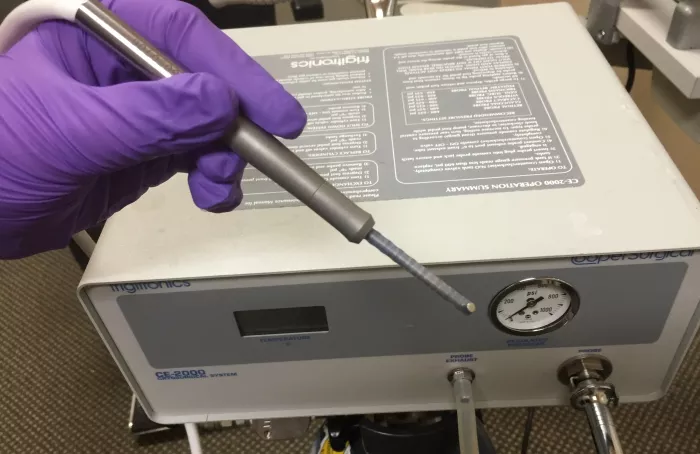Cryopexy is a medical procedure used to treat retinal tears or detachments. It involves using extreme cold to freeze the retina, creating a scar that helps seal the tear and prevent further damage. This procedure is often recommended when a retinal tear is detected early, as it can prevent the retina from detaching completely.
This article will provide a detailed guide on cryopexy for retinal tears, including what it is, why it’s needed, the procedure, recovery process, and what to expect. By the end, you’ll have a clear understanding of how cryopexy can help protect your vision.
What Is Cryopexy?
Cryopexy, also known as cryotherapy, is a procedure that uses freezing temperatures to treat retinal tears or detachments. The cold creates a scar that seals the retina to the underlying tissue, preventing fluid from leaking through the tear and causing further detachment.
Why Is Cryopexy Needed?
Cryopexy is typically recommended for patients with:
Retinal Tears: Small breaks in the retina that can lead to detachment if left untreated.
Lattice Degeneration: Thinning of the retina that increases the risk of tears.
Early Retinal Detachment: Partial detachment that hasn’t progressed significantly.
Early treatment with cryopexy can prevent the retina from detaching completely, which can lead to permanent vision loss.
How Does Cryopexy Work?
Cryopexy works by freezing the retina around the tear, creating a scar that seals the retina to the underlying tissue. Here’s how the procedure is performed:
Preparation: The eye is numbed with local anesthesia, and a special freezing probe is used.
Freezing: The probe is applied to the outer surface of the eye, freezing the retina around the tear.
Healing: Over time, the frozen area forms a scar that seals the retina in place.
The procedure is usually quick, taking about 15-30 minutes, and is performed in an outpatient setting.
What to Expect During Cryopexy
Here’s a step-by-step overview of what happens during cryopexy:
Preparation: The eye is cleaned, and anesthesia is administered.
Freezing: The surgeon applies the freezing probe to the outer surface of the eye.
Completion: The probe is removed, and the eye is checked for proper healing.
Most patients experience little to no pain during the procedure, though some may feel slight pressure or cold.
Recovery After Cryopexy
Recovery from cryopexy is usually quick, but here’s what to expect:
Immediate Aftercare:
- Use prescribed eye drops to prevent infection and reduce inflammation.
- Wear an eye shield at night to protect the eye.
Activity Restrictions:
- Avoid strenuous activities, heavy lifting, or bending over for a few days.
- Follow your surgeon’s instructions on when to resume normal activities.
Follow-Up Appointments:
Regular check-ups are essential to monitor healing and check for complications.
Vision Changes:
- Your vision may be blurry or distorted during recovery.
- It may take a few weeks for your vision to stabilize.
Risks and Complications
While cryopexy is generally safe, it does carry some risks, including:
- Infection.
- Bleeding.
- Increased eye pressure.
- Temporary blurred vision.
Your surgeon will discuss these risks with you and take steps to minimize them.
Conclusion
Cryopexy is a highly effective treatment for retinal tears and early detachments. By understanding the procedure, its benefits, and what to expect during recovery, you can approach treatment with confidence. If you’re experiencing symptoms like floaters, flashes of light, or vision loss, consult an eye specialist promptly. Early intervention can make a significant difference in preserving your sight.
If you have more questions about cryopexy or need personalized advice, don’t hesitate to reach out to your eye care provider. Your vision is precious, and taking proactive steps to protect it is always worth it.
Frequently Asked Questions
1. How long does cryopexy take?
Most procedures take 15-30 minutes, but this can vary depending on the complexity.
2. Is cryopexy painful?
Local anesthesia is used, so you shouldn’t feel pain during the procedure. Some discomfort may occur during recovery.
3. Can I drive after cryopexy?
You’ll need someone to drive you home after the procedure. Avoid driving until your doctor approves.
4. Will I need multiple treatments?
In most cases, a single cryopexy treatment is sufficient, but follow-up care is essential.
5. What happens if I don’t get cryopexy?
Without treatment, a retinal tear can lead to retinal detachment and permanent vision loss.
Related topics:
Can Eye Drops Cause Cataracts? What You Need to Know
Can Optometrists Perform Laser Eye Surgery? A Complete Guide
How Much Does Under Eye Plastic Surgery Cost?

